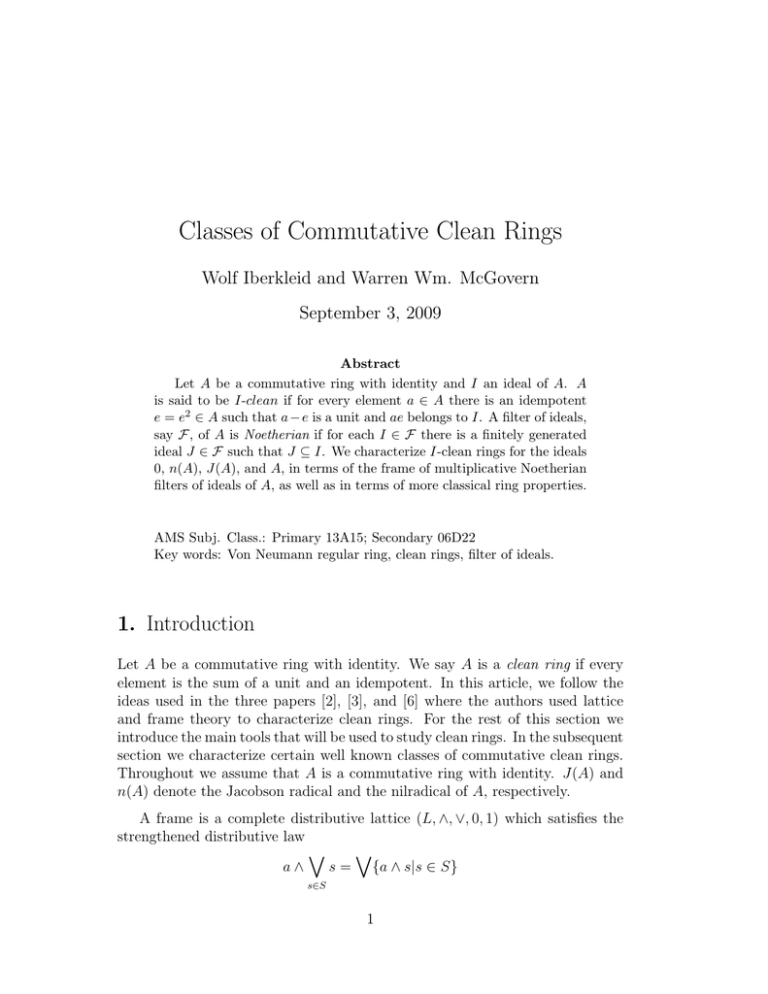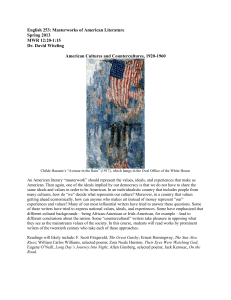Classes of Commutative Clean Rings Wolf Iberkleid and Warren Wm. McGovern
advertisement

Classes of Commutative Clean Rings
Wolf Iberkleid and Warren Wm. McGovern
September 3, 2009
Abstract
Let A be a commutative ring with identity and I an ideal of A. A
is said to be I-clean if for every element a ∈ A there is an idempotent
e = e2 ∈ A such that a − e is a unit and ae belongs to I. A filter of ideals,
say F, of A is Noetherian if for each I ∈ F there is a finitely generated
ideal J ∈ F such that J ⊆ I. We characterize I-clean rings for the ideals
0, n(A), J(A), and A, in terms of the frame of multiplicative Noetherian
filters of ideals of A, as well as in terms of more classical ring properties.
AMS Subj. Class.: Primary 13A15; Secondary 06D22
Key words: Von Neumann regular ring, clean rings, filter of ideals.
1. Introduction
Let A be a commutative ring with identity. We say A is a clean ring if every
element is the sum of a unit and an idempotent. In this article, we follow the
ideas used in the three papers [2], [3], and [6] where the authors used lattice
and frame theory to characterize clean rings. For the rest of this section we
introduce the main tools that will be used to study clean rings. In the subsequent
section we characterize certain well known classes of commutative clean rings.
Throughout we assume that A is a commutative ring with identity. J(A) and
n(A) denote the Jacobson radical and the nilradical of A, respectively.
A frame is a complete distributive lattice (L, ∧, ∨, 0, 1) which satisfies the
strengthened distributive law
_
_
a∧
s = {a ∧ s|s ∈ S}
s∈S
1
for all a ∈ L and all S ⊆ L. This equality is known as the frame law. We denote
the bottom and top elements of a frame by 0 and 1, respectively (and assume
that 0 6= 1).
A frame is necessarily a pseudocomplemented lattice (in the sense of Birkhoff
[4]). In particular, for a ∈ L the pseudo-complement of a is given by
_
a⊥ = {t ∈ L : t ∧ a = 0}.
An element of the form a⊥ is called a pseudocomplement of L. When a ∨
a⊥ = 1, we say that a is a complemented element of L and that a and a⊥
form a complementary pair. It is not true that if a⊥ is complemented, then
a is complemented. We point out that frames are also known as complete
Brouwerian lattices or complete Heyting algebras. They are also very often
called locales.
Definition 1.1 We now recall some basic notions regarding frames. Throughout, L denotes a frame.
W
(i) Let c ∈ L. We call c compact if whenever c ≤ i∈I ai , then there is a
finite subset of I, say {i1 , · · · , in }, such that c ≤ ai1 ∨ · · · ∨ ain . If the top
element of L is compact, then we call L compact. Whenever every element
of L is the supremum of compact elements, L is called an algebraic frame.
We denote the set of compact elements of L by k(L). This collection
is closed under finite joins. When k(L) is closed under nonempty finite
meets, then we say that L has the finite intersection property, or that
L satisfies the FIP. A compact algebraic frame that satisfies the FIP is
known as a coherent frame
(ii) L is said to be zero-dimensional when every element is a supremum of
complemented elements. It is straightforward to check that for an algebraic frame being zero-dimensional is equivalent to having the property
that every compact element is complemented.
(iii) Suppose L is an algebraic frame. L is called a projectable frame if for every
c ∈ k(L) the element c⊥ is a complemented element of L. L is called feebly
projectable if for any disjoint a, b ∈ k(L) there exists a c ∈ k(L) such that
c⊥ is complemented, a ≤ c⊥ , and b ≤ c⊥⊥ . Every zero-dimensional frame
is projectable and every projectable frame is feebly projectable.
Example 1.2 There are several ways of generating frames from rings. For
example, it is known that the collection of ideals of a commutative ring forms
2
a complete lattice which is algebraic. It is a frame precisely when the ring
is an arithmetical ring, i.e., its lattice of ideals is distributive. Restricting to
the collection of radical ideals (or semiprime ideals) of a ring A, one obtains a
coherent frame. (This frame is the main tool in [2, 3].)
Another source of frames arises from studying filters of ideals. Let A be a ring
and let L(A) denote the complete lattice of ideals of A ordered by inclusion.
A subset F ⊆ L(A) is a filter of ideals if the following conditions hold for
I, J ∈ L(A):
(i) ∅ 6= F;
(ii) if I ∈ F and I ⊆ J, then J ∈ F;
(iii) if I, J ∈ F, then I ∩ J ∈ F.
The filter F is called a multiplicative filter if
(iv) IJ ∈ F whenever I, J ∈ F.
Definition 1.3 A filter of ideals F is said to be Noetherian if every ideal belonging to F contains a finitely generated ideal, which also belongs to F.
We denote the collection of all multiplicative filters of ideals of A by MA
partially ordered by inclusion. In [6] it is shown that MA is a coherent frame.
Let CA be the subcollection of multiplicative Noetherian filters. We now prove
that CA is a coherent frame as well, though we do point out that the technique is
slightly different. We will need to use the following notation. Given any ideal I
of A there is a smallest multiplicative filter containing I called the multiplicative
filter generated by I. Namely,
FI = {J ∈ L(A) : I n ⊆ J, for some n ∈ N}.
Theorem 1.4 CA is a coherent frame and the compact elements are precisely
the filters of the form FI for some finitely generated ideal I ∈ L(A).
Proof. For an arbitrary collection {Fi } of elements of CA , it is easily seen that
_
Fi = {I ∈ L(A) : Ii1 ...Iin ⊆ I for some finitely generated Iik ∈ Fik , n ∈ N}.
From this we deduce that CA is a complete lattice. Note that the intersection
of two Noetherian filters is Noetherian. For if F1 , F2 ∈ CA and I ∈ F1 ∩ F2 ,
then there are finitely generated ideals J1 , J2 in F1 , F2 , respectively, such that
3
J1 , J2 ⊆ I, hence J1 +J2 ∈ F1 ∩F2 and J1 +J2 ⊆ I. Therefore, F1 ∧F2 = F1 ∩F2 .
Next we prove that CA is distributive. We have to show that F ∧(F1 ∨F2 ) =
(F ∧F1 )∨(F ∧F2 ) for arbitrary elements of CA . Let I ∈ F ∧(F1 ∨F2 ) and F, F1 ,
and F2 ∈ CA , so I must be in F and in F1 ∨ F2 . Therefore, there exist finitely
generated ideals J, J1 , J2 in F, F1 , F2 , respectively, such that J ⊆ I, J1 J2 ⊆ I.
Clearly then (J + J1 )(J + J2 ) ⊆ I. But this implies that I ∈ (F ∧ F1 ) ∨ (F ∧ F2 ).
Since the other inclusion is trivial we conclude that CA is distributive.
Since a finite product of finitely generated ideals is again finitely generated,
it follows that for any finitely generated W
ideal I of A, FI ∈ CA . Moreover, FI
is a compact element of CA , for if FI ≤ Fi , then Ii1 ...Iin ⊆ I for some finite
collection of finitely generated ideals Iik ∈ Fik , hence FI ≤ Fi1 ∨ · · · ∨ Fin .
Furthermore, for any F ∈ CA ,
F=
_
{FI : I is finitely generated and I ∈ F}
and thus CA is an algebraic distributive lattice, whence a frame. To see that
CA has the FIP observe that for any finitely generated ideals I, J ∈ L(A),
FI ∧ FJ = FI+J . Finally, if F is also compact, then F = FI1 ∨ ... ∨ FIn = FI1 ...In
for appropriate finitely generated ideals I1 , · · · , In ∈ F . This concludes the
proof.¥
Remark. We note that CA is a subframe of MA , specifically CA is a frame
which is a sublattice of MA whose arbitrary union in CA agrees with MA .
Lemma 1.5 The complemented elements of CA are precisely the elements of
the form FAe for some idempotent e ∈ A.
Proof. Let F ∨ G = 1 and F ∧ G = 0, then there exist finitely generated ideals
I ∈ F and J ∈ G such that IJ = 0. In addition for all K ∈ F , K + J = A, so
I = I(K + J) = IK ⊆ K therefore, F ⊆ FI , but then F = FI . Now it is easy
to show that IJ = 0, I + J = A implies that I = Ae for some idempotent e.¥
Lemma 1.6 Let I ∈ L(A) be a finitely generated ideal. Then FI⊥ = {K ∈
L(A) : there is a finitely generated ideal J ⊆ K such that I + J = A}.
Proof. It suffices to note that if J1 , J2 are finitely generated ideals such that
I + J1 = A and I + J2 = A, then J1 J2 is finitely generated and I + J1 J2 = A,
hence the above defined set is a multiplicative Noetherian filter.¥
4
2. Clean Rings
Let I be an ideal of A. A is said to be an I-clean ring if for every a ∈ A there
is an idempotent e such that a − e is a unit and ae ∈ I. Note that an A-clean
ring is precisely a clean ring.
More Generally, A is said to be a weakly I-clean ring if for every a ∈ A there
is an idempotent e such that ae ∈ I and at least one of a + e and a − e is a unit.
We shall state this by saying that a ± e is a unit. It turns out that in most cases
considered here weakly I-clean is equivalent to I-clean. See [1].
The purpose of this section is to characterize such rings for the ideals 0,
n(A), J(A), and A, in terms of the frame of multiplicative Noetherian filters
of ideals of A, and in terms of more classical ring properties. In particular, we
give a common structure to clean, zero dimensional, and von Neumann regular
rings, and add to the results in [5] pp. 10, 11.
Recall that a ring A is von Neumann regular if for every a ∈ A there is an
x ∈ A such that a = a2 x. A ring is zero-dimensional if every prime ideal is
maximal.
Definition 2.1 Recall that Spec(A) denotes the collection of all prime ideals
of A endowed with the hull-kernel or Zariski topology. If I is an ideal of A, then
U (I) is the set of all those prime ideals of A that do not contain I. All open
sets are determined this way. The complement of U (I) is denoted V (I). For the
principal ideal Aa we denote U (a) = U (Aa) and V (a) = V (Aa). M ax(A) is the
subspace of Spec(A) consisting of the maximal ideals of A. Its open and closed
sets are UM (I) = U (I) ∩ M ax(A) and VM (I) = V (I) ∩ M ax(A), respectively.
Theorem 2.2 The following are equivalent:
(1) A is 0-clean.
(2) A is weakly 0-clean.
(3) A is a von Neumann regular ring.
(4) For finitely generated ideals I and J with FI = FJ , then I = J.
(5) For finitely generated ideals I and J with V (I) = V (J) in Spec(A), then
I = J.
Proof. (1) implies (2). Clear.
(2) implies (3). Let a ∈ A. Then a = u ± e and ae = 0 where u is a unit
and e an idempotent. Therefore, a2 = au and so a2 u−1 = a whence A is a von
Neumann regular ring.
5
(3) implies (4). It is well known that in a von Neumann regular ring, each
finitely generated ideal I is a principal ideal generated by an idempotent, so
I n = I for any natural number n. From this it follows that I is smallest in FI ,
hence the assertion is clear.
(4) implies (5). We argue by contradiction. If I 6= J, then FI 6= FJ , thus
say I n 6⊆ J for all natural n. Let a1 , . . . , am be a set of generators of I. We need
only show that {ani }n ∩ J = ∅ for some ai and apply Zorn’s Lemma. But this
must be the case, otherwise there would be an n with ani ∈ J for all ai , hence
I nm ⊆ J, which is a contradiction. We conclude that V (I) 6= V (J).
(5) implies (1). Let a ∈ A, then V (a) = V (a2 ) implies Aa = Aa2 , so a = xa2
for some x. Clearly xa is an idempotent and a(1 − xa) = 0. Moreover, for any
maximal ideal M , a ∈ M iff 1 − xa ∈
/ M , so a − (1 − xa) is a unit therefore, A
is 0-clean. ¥
Theorem 2.3 The following are equivalent:
(1) A is n(A)-clean.
(2) A is weakly n(A)-clean.
(3) For every a ∈ A there is an idempotent e such that V (a) = U (e) in
Spec(A).
(4) For every finitely generated ideal I of A there is an idempotent e such that
V (I) = U (e) in Spec(A).
(5) For every finitely generated ideal I of A there is an idempotent e such that
I n = Ae for some natural number n.
(6) CA is a zero-dimensional frame.
(7) For every a ∈ A there exists a natural number n and an idempotent e such
that Aan = Ae.
(8) A is zero dimensional.
Proof. (1) implies (2). Clear.
(2) implies (3). Given a ∈ A, let a = u ± e with ae ∈ n(A), u a unit and e
an idempotent. Let P be a prime ideal, then ae ∈ P . Since P is prime at least
one of a and e must be in P , and since u is a unit, at most one of a and e may
be in P . This translates into V (a) = U (e).
6
(3) implies (4). Let a1 ,. . . ,an be a set of generators for I, and ei , the corresponding idempotents. Then V (I) = ∩V (ai ) = ∩U (ei ) = U (e1 · · · en ) where
e1 · · · en is an idempotent.
(4) implies (5). We wish to prove that for a finitely generated ideal I,
n
I = A(1 − e) for some natural number n, and e as in the hypothesis. This
would prove our assertion since 1 − e is an idempotent. Let a ∈ I and assume
that an ∈
/ A(1 − e) for all natural numbers n. Then {an } forms a multiplicative
closed set disjoint from A(1−e). By a Zorn’s Lemma argument, there is a prime
ideal P , a ∈
/ P and A(1 − e) ⊆ P . Thus e ∈
/ P so, by hypothesis, I ⊆ P . But
n
this is a contradiction. Therefore, a ∈ A(1 − e) for some n. Since I is finitely
generated, it follows that I n ⊆ A(1 − e) for some n. Say now that 1 − e ∈
/ I n,
then 1 − e ∈
/ I. Since {1 − e} is a multiplicative closed set disjoint from I, by
the same argument, there is a prime ideal P with I ⊆ P and 1 − e ∈
/ P , so
n
e ∈ P . But this contradicts the hypothesis, so A(1 − e) ⊆ I . This concludes
the assertion.
(5) implies (6). All compact elements of CA are of the form FI , for some
finitely generated ideal I. Since CA is algebraic, it suffices to prove that these are
complemented. But by hypothesis, I n = Ae, and it is clear from the definition
of principal filter that FI n = FI , so FI = FAe . It now follows from Lemma 1.5
that FAe is complemented, therefore CA is zero-dimensional.
(6) implies (1). By Lemma 1.5 and the hypothesis, given any finitely generated ideal I, there is an idempotent e such that FI = FAe . In particular if we
let Aa = I for some arbitrary a ∈ A, then for any prime ideal P we have that
a ∈ P iff P ∈ FAa iff P ∈ FAe iff e ∈ P iff 1 − e ∈
/ P . Therefore, a − (1 − e) ∈
/P
and a(1 − e) ∈ P for all prime ideals P in A, hence a − (1 − e) is a unit and
a(1 − e) ∈ n(A). In other words A is n(A)-clean.
Since (7) and (8) are equivalent ([8], Lemma 5.6), and (5) clearly implies
(7), it only remains to show (7) implies (3). Given a ∈ A and the hypothesis,
then for any prime P , P ∈ V (a) iff P ∈ V (an ) iff P ∈ V (e) iff P ∈ U (1 − e).
Therefore, V (a) = U (1 − e). ¥
Theorem 2.4 The following are equivalent:
(1) A is J(A)-clean.
(2) A is weakly J(A)-clean.
(3) For every a ∈ A there is an idempotent e ∈ A such that VM (a) = UM (e).
(4) For every finitely generated ideal I of A there is an idempotent e ∈ A such
that VM (I) = UM (e).
7
(5) For every finitely generated ideal I of A there is an idempotent e ∈ A such
that I + J = A iff Ae ⊆ J, for any finitely generated ideal J.
(6) CA is a projectable frame.
(7) A/J(A) is von Neumann regular and idempotents lift mod J(A).
Proof. (1) implies (2). Clear.
(2) implies (3). Given a ∈ A, let a = u ± e with ae ∈ J(A), u a unit and e
an idempotent. Let M be a maximal ideal, then ae ∈ M . Since M is prime at
least one of a and e must be in M , and since u is a unit, at most one of a and
e may be in M . This translates into V (a) = U (e).
(3) implies (4). Let a1 ,. . . ,an be a set of generators for I, and ei , the corresponding idempotents. Then VM (I) = ∩VM (ai ) = ∩UM (ei ) = UM (e1 · · · en )
where e1 · · · en is, of course, an idempotent.
(4) implies (5). Let I, J be finitely generated ideals of A and VM (I) = UM (e).
If I + J 6= A, then there is a maximal ideal M with I + J ⊆ M . Now I ⊆ M
implies that e ∈
/ M , so e ∈
/ J. Conversely, assume that e ∈
/ J. Note that in this
case J +A(1−e) 6= A, for otherwise there are a ∈ A, b ∈ J, with b+a(1−e) = 1.
Multiplying by e gives e = eb ∈ J, a contradiction. So there is a maximal ideal
M with J + A(1 − e) ⊆ M . But then, e cannot be in M , which means that
I ⊆ M , so I + J ⊆ M . Thus I + J 6= A.
(5) implies (6). Given a finitely generated ideal I of A there is an idempotent
e such that I + J = A iff Ae ⊆ J, for any finitely generated ideal J. Now, by
Lemma 1.6, it follows that FI⊥ = FAe . Therefore, by Lemma 1.5 and Theorem
1.4, CA is a projectable frame.
⊥
(6) implies (1). Let a ∈ A, then by Lemma 1.5, FAa
= FAe for some
idempotent e. So by Lemma 1.6 for all finitely generated ideals J of A, Aa+J =
A iff Ae ⊆ J. Let M be a maximal ideal. Now a ∈
/ M iff Aa+M = A iff Ae ∈ M
iff e ∈ M . So, for every maximal ideal M , a − e ∈
/ M and ae ∈ M , which means
a − e is a unit and ae ∈ J(A), thus A is J(A)-clean.
(1) implies (7). By Theorem 2.2, A/J(A) is von Neumann regular. Now
suppose that a + J(A) is an idempotent, so a(a − 1) = a2 − a ∈ J(A), therefore,
for any maximal ideal M , a ∈ M iff a − 1 ∈
/ M . Now a = u + e with ae ∈ J(A)
so a ∈ M iff e ∈
/ M iff 1 − e ∈ M . From these equivalences it is clear that
a − (1 − e) ∈ M for all maximal ideals, so a − (1 − e) ∈ J(A). Therefore,
a + J(A) lifts to 1 − e.
(7) implies (1). By hypothesis and Theorem 2.2, for any a ∈ A, a−e+J(A) is
a unit in A/J(A) and ae ∈ J(A), so a − e is a unit in A, thus A is J(A)-clean.¥
Theorem 2.5 The following are equivalent:
8
(1) A is clean.
(2) The collection {U (e) ⊆ M ax(A) : e is idempotent} is a basis of clopen
sets for M ax(A).
(3) CA is feebly projectable.
Proof. (1) is equivalent to (2). See [7].
(2) implies (3). It is well known that M ax(A) is compact but with our
hypothesis it is also Hausdorff, and therefore M ax(A) is a normal Hausdorff
space. Assume now that FI ∧ FJ = 0 where I, J are finitely generated ideals
of A. Since I + J = A, there are a ∈ I, b ∈ J with a + b = 1. Therefore,
V (a) and V (b) are disjoint closed sets. Since we can separate disjoint closed
sets by a clopen set in our base there is an idempotent e with V (a) ⊆ U (e) and
V (b) ⊆ U (1 − e). We claim now that a(1 − e) + be cannot be in any maximal
ideal. For suppose a(1 − e) + be ∈ M , then a(1 − e), be ∈ M . If 1 − e 6∈ M , then
a ∈ M , so M ∈ U (e). But this is a contradiction since one of e and 1 − e must
belong to M . We reach a similar contradiction if we assume that e 6∈ M , so we
conclude that a(1 − e) + be is a unit. From this it is easy to show that FAa(1−e)
and FAbe contain FI and FJ , respectively, and are complementary.
(3) implies (2). Let M ∈ U (a), so that there is a b ∈ M such that a + b = 1,
so FAa ∧ FAb = 0. By hypothesis and Lemma 1.5 there is an idempotent e such
that FAa ≤ FAe and FAb ≤ FA(1−e) , so Ae ⊆ Aa and A(1 − e) ⊆ Ab, thus
M ∈ U (e) ⊆ U (a). We conclude that the U (e)’s form a base for the Zariski
topology on M ax(A). ¥
References
[1] Ahn, M.S. and Anderson, D.D. Weakly clean rings and almost clean
rings. Rocky Mountain J. of Math. 36(3), 783-798 (2006).
[2] Banaschewski, B. Ring theory and point free topology. Top. Appl. 137,
21-37 (2004).
[3] Banaschewski, B. Gelfand and exchange rings: their spectra in pointfree topology. Arab. J. Sci. Eng. Sect. C Theme Issues. 25(2), 3-22
(2000).
[4] Birkhoff G. Lattice Theory. Colloquium Publ. 25, Amer. Math Societ.
Providence (1979).
9
[5] Huckaba, J.A. Commutative rings with zero divisors. Monographs and
Textbooks in Pure and Applied Mathematics, 117, Marcel Dekker,
Inc. New York (1988).
[6] Knox, M.L. and McGovern, W.W. Feebly projectable algebraic frames
and multiplicative filters of ideals. Appl. Categ. Structures, to appear.
[7] McGovern, W. Wm. Neat Rings. J. Pure Appl. Alg. 205, 243-265
(2006).
[8] Storrer, J.J. Epimorphismen von kommutativen Ringen. Comment.
Math. Helvetici 43,378-401 (1968).
10







